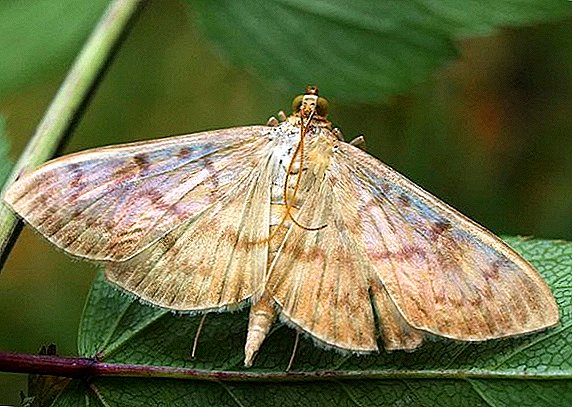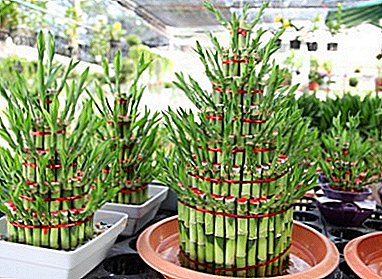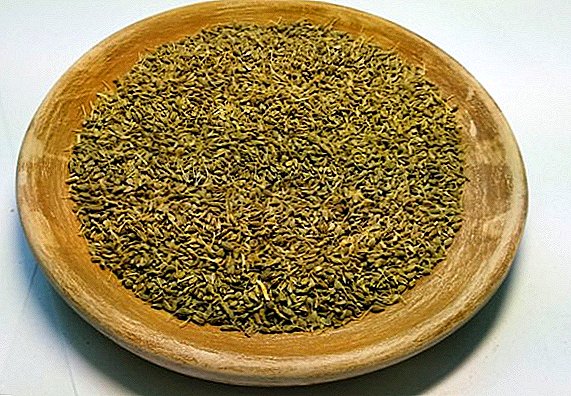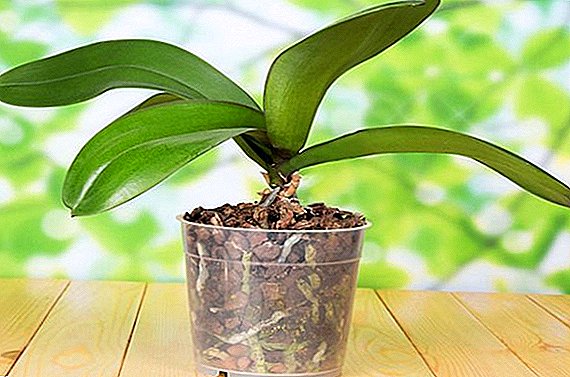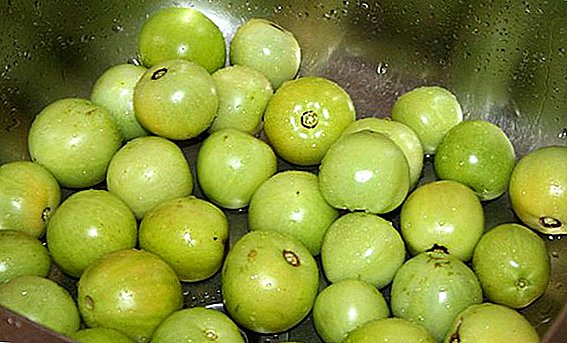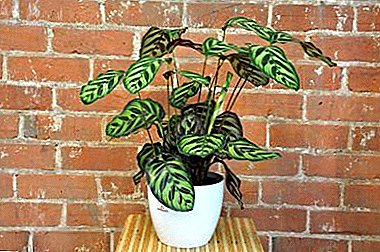
Calathea Makoya is a very capricious plant.
Recommended only by professional flower growers.
He needs a special atmosphere and humidity.
Therefore, the flower is best contained in terrariums, florariums, winter or botanical gardens.
Plant description
Calathea Makoya - herbaceous perennial. It belongs to the Marantaceae family. It grows in the tropics of Brazil. Latin name: Calathea makoyana. In width and in height reaches 25-45 cm. It has a shortened stem.
A large rosette with elongated leaves leaves it. Egg-shaped leaf plate. The length reaches 18-22 cm, width - 8-12 cm. The leaves are elegant, thin, almost translucent.
The plant is loved by gardeners for an unusual characteristic color. Top surface of emerald green leaves. From the center of the sheet plate snow-white strokes depart, forming the background. On it are held elongated ovate spots.
If you look at the leaves from above, the picture is very similar to the emerald tree on the background of snow-white spikelets and green grass. The seamy side of the leaf plate is identical to the upper side. But instead of an emerald pattern, there is a crimson background. Flowers tiny, lilac color. Collected in dense inflorescences.
Check out other sorts of Calathea: Saffron, Rufibarba, Medallion, Lansifolia, Zebrin, Varshevich.
A photo
Visually with Makatoy Kalatea can be found in the photo below:




Home care
Crown formation
The flower does not need to form a crown. But after flowering, dry flowers or dried stems can be cut.
Watering
When watering Calathea is very capricious. She needs soft water without any chemical impurities. therefore watering the plant with water from the tap is strictly prohibited. Water needs to be boiled or filtered.
Flower can not be poured. Otherwise, the plant will begin to rot the roots. The best option is to wait for the topsoil to dry. It is advisable to choose the mode of irrigation, in which the earth in the tank will be in constant slight moisture.
Air humidity
Since the flower is imported from the tropics, it needs a very high humidity. The best option is 88-91%.
Attention! To spray a plant with water from a sprayer is strictly prohibited!
Do not allow moisture to fall on the boles and decorative leaves of Makoi.
If you start to spray it, this method will lead to severe illness and death. Therefore, the only option to maintain in the room moist air - a pallet with moist clay or moss.
 The dishes are placed either next to the flower, or under a container.
The dishes are placed either next to the flower, or under a container.
It is very important that at the bottom of the pot in which this representative of the flora grows, there are drainage holes.
Otherwise, air will not flow to the root system of the flower.
Also Kalatee can provide a permanent greenhouse regime.
Experienced growers contain the plant in terrariums and florariums.
Also, the flower grows well in winter and botanical gardens, in which professional staff create the plant all the necessary conditions for growth.
Landing
The plant is very demanding to the ground. It must be nutritious, fortified with plenty of minerals and trace elements. The flower actively grows in a weakly acidic environment.
Importantso that the earth is breathable, loose and porous.
For planting, you can use the purchased soil for home flowers of Saintpaulia or prepare the substrate yourself. To do this, you will need sheet soil, peat tablets or peat, humus and fine-grained sea sand. Also for the permeability of the mixture is added coal.
At the bottom of the bowl make holes and fill the drainage layer. Perfect pebbles, expanded clay, broken shards. Drainage protects the root system from unwanted stagnant water.
Black earth is poured on top. A plant is placed in the center and covered with the prepared substrate. After planting, the flower must be plentifully watered and placed in a windless bright room.
Top dressing
Fertilizers need to be very careful.. Once in 14 days, the dressing is diluted in water and the plant is watered.
Feed must be made in half the amount indicated in the instructions. Since the purchase of fertilizers for perennials can burn the root system.
Transfer
 Transplantation is made in the spring. It is possible to replant a flower annually. To do this, choose a container larger in size than the previous one.
Transplantation is made in the spring. It is possible to replant a flower annually. To do this, choose a container larger in size than the previous one.
Since the roots of the flower are close to the edge, it is necessary to choose miniature wide bowls.
When transplanting is strictly forbidden to tamp the soil. The earth must be loose and breathable.
Breeding
Flower propagated by delenki. When transplanting the root system is divided into several parts.
Important, so that in each bush there are several stems with developed leaves and rosettes.
With a sharp knife or clippers, the roots are carefully separated from each other. Then transplanted into containers for constant growth.
Temperature
The plant has a negative attitude to the sultry heat and cold. In summer, the flower must be maintained at a temperature of 19-23 ° C. In winter, the temperature should not fall below 17 ° C.
This representative of flora negatively relates to drafts, winds. With a long stay on gusts of air - it can get very sick and die.
Lighting
The plant loves bright natural light. Throughout the year, daylight hours should be at least 15-17 hours.
Therefore, in winter, the plant is artificially highlighted. When growing in the shade and lack of light, the flower loses its decorative effect.
Pests
The plant may be affected by pests. With strong dusting spider mites appear. When it is detected, the leaves are washed with a solution of soap. Then the flower is bathed under a stream of warm soul.
 Also this flora representative may be susceptible to thrips and scutes.
Also this flora representative may be susceptible to thrips and scutes.
Important to rememberthat the plant can not be sprayed.
Therefore, to eliminate insects using the usual wet cotton wool. With it, remove the pests manually.
Can wet a cotton swab with alcohol or regular alcohol.
After the insects are removed from the flower, they are eliminated with the help of chemical preparations.
Pests are placed in a jar and sprayed on its surface. Perfectly suitable "Ferrovit", "Aktellik", "Agravertin", "Fitoverm". If the pests are simply washed off with water or thrown away, they can creep back onto the indoor flowers.
Also another method of getting rid of pests - folk. A transparent plastic bag is put on the flower. Inside put a cotton swab moistened with dichlorvos.
The procedure is very complicated.
Importantso that the cotton does not touch the stump or the leaves of the flower.
This may adversely affect the health of the plant. After that, the bag is removed and the pests are manually removed with cotton wool dipped in alcohol.
Diseases
Important to rememberthat Calathea Makoya is a very capricious plant.
Therefore, all diseases occur only from improper care. Leaves can dry and turn yellow from an overabundance of moisture, unwanted sprays of water, lack of light. Also from moisture on the leaves and shtamb plants.
Calathea Makoya - a very naughty perennial. Requires special care. The plant needs systematic watering with boiled water, constant illumination even in winter, additional feeding.
The flower can not be poured and sprayed from the sprayer. You can not make chemicals from pests. The plant prefers rest, bright warm rooms without winds and drafts.


